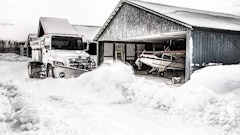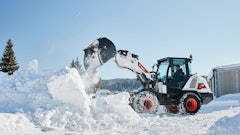
Looking for ways to optimize your wheeled equipment for snow removal? The secret is in the tires. Selecting the right tires and maintaining those tires will carry your wheeled equipment through the snow season with coveted results.
From Yokohama:
Inflation Pressure. For every 10-degree drop in temperature, tires lose one pound of pressure. Keep your tires properly inflated to avoid safety hazards, stress, excess heat build-up and decreased fuel efficiency. Check your equipment’s psi first thing in the morning on a regular basis to get the most accurate reading.
Radial Construction. Low inflation pressure is best for snow removal, but bad for tires. Luckily, radial tires can operate at lower inflation pressures, allowing for more tread on the ground and increased traction. Radial construction also dissipates heat better than bias-ply tires, lengthening the service life of your tires.
Tread Carefully. Any tire can get the job done, but it’s a block tread that gets the job done efficiently in snow and ice. Tires specifically designed for winter work feature treads with the ability to grip and flex in cold weather and sipes to add traction and clear snow from treads.
Inspect to Expect. What you don’t know can become hazardous. Know what to expect by inspecting your equipment’s rims and tires for signs of abraded sidewalls, impact damage and salt corrosion or deterioration. Check that your tread is not worn and clear any salt residue from your rims and tires before storing your equipment for the night. A quick inspection can save you time, money and future headaches in the long run.
Operation Education. Operator error is a major player in a tire’s lifespan. Uneven wear from excessive downforce while plowing, hard-cut turns, surpassing speed and load limitations of equipment and being unprepared for potential hazards can not only ruin your tires, but also put your drivers in unsafe positions. Instead, take the time to educate your operators on performing three-point turns to save rubber and reduce stress on tires, assign your operators to particular areas for efficiency and familiarity with the route, and train them to recognize hazards such as curbs and raised manholes.






























